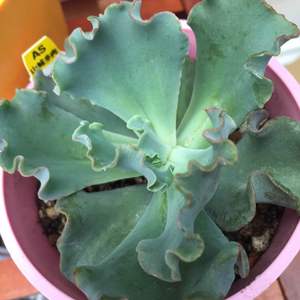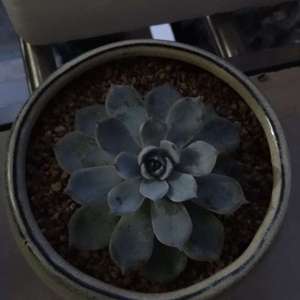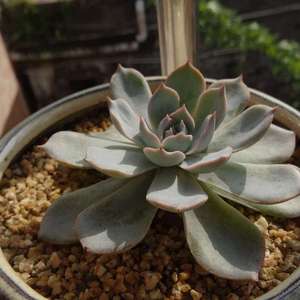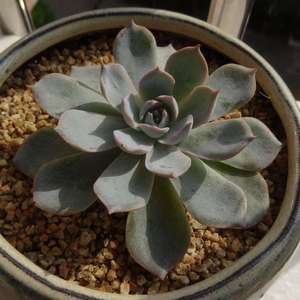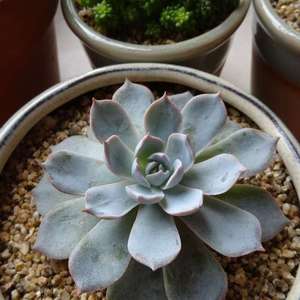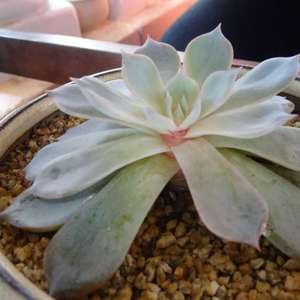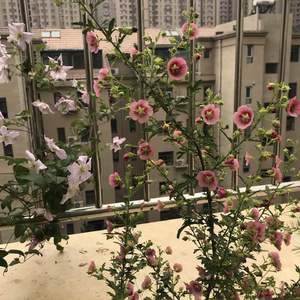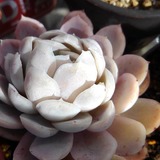文章
Miss Chen
2018年06月23日

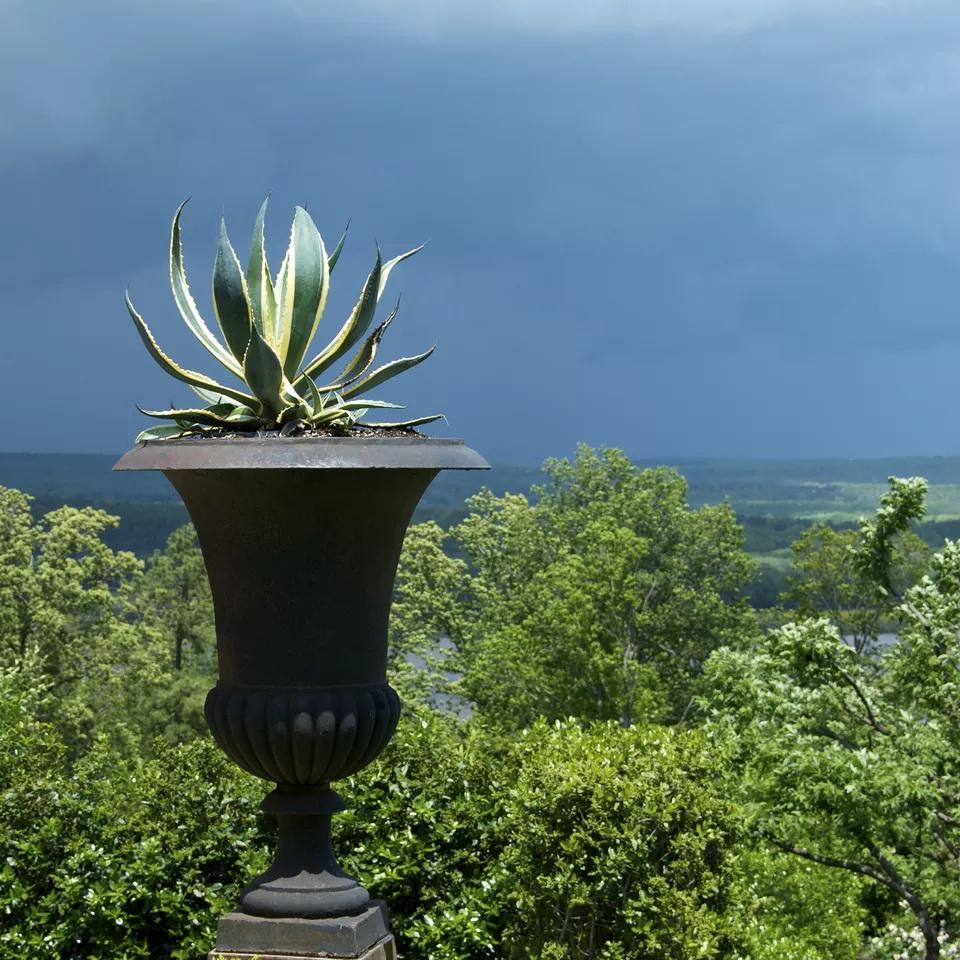
1.Agave in a Garden Pot
Succulent plants make great, easy container garden plants.
Succulent are one of my favorite container garden plants. They are low-maintenance, beautiful and they come in stunning colors, many different sizes, textures and shapes.
I am somewhat in awe of agaves. They are beautiful, striking and somewhat lethal, given their spikes, sharp tips and potentially toxic sap. Despite their seemingly hostile appearance they are fairly good-natured plants - not difficult to care for and tolerant of cool temperatures. Though they prefer hot, full sun, agaves will tolerate some shade.
P. Allen Smith uses agaves to great dramatic affect. Potted in large, dark containers, they punctuate the landscape and add a modern, sculptural sensibility as well as vertical interest.

2.Succulents on the Half Shell
These clamshells are packed full of succulent plants. They can be used for table decorations and make great house presents. You can use a mix of succulent plants, or use one type. These are planted with a few different kinds of hens and chicks, and some tiny echeverias.
As when planting any succulent, use either a potting soil made specifically for succulents and cacti, or make your own by taking a good quality potting mix and adding either pumice or perlite. Make sure to use a container that either has drainage holes one that you can punch or drill holes in. Drainage is key to keeping your succulents healthy.
To care for these miniature container gardens, give them full sun, or if you are in a very hot climate, keep them in partial shade. Do not over-water. During the growing season, keep the soil moist, but not wet. During the winter, when succulents go into dormancy, let the soil dry out between waterings.
Hens and chicks are incredibly forgiving plants. They are extremely hardy - most of them can survive in zone 3, and can tolerate poor soil.
For Step by step instructions on making clam shell container gardens.

3.Succulents in a Lunchbox
You can plant succulents in almost anything. Because of their shallow root structure, you don't need a very deep pot. You do need good drainage though. I took a large nail and hammered so many holes in the bottom of this box, that by the time I was done, it looked like Swiss cheese.
Because the metal is pretty thin, I made sure to punch the holes with the metal sitting directly on the ground, so it wouldn't bend the box.
After I punched the holes, I lined the box with plastic also with holes, so it wouldn't rust as quickly. I then filled it with a potting mix specifically designed for cacti and succulents. I packed the box full of plants, putting the ones that I knew would drape, near the edges, and the larger plants near the back.
The box sits in full sun, and I water it enough to keep the soil moist, but not wet. I'll bring it inside in the late fall and keep it in bright, indirect light. In the winter I'll let the soil dry out completely between waterings.
0
0
文章
Miss Chen
2018年06月21日

Description: This perennial plant is ¾–2½' long. It either floats on water or sprawls across the ground. The stems are light green to red (often the latter), glabrous to sparsely pubescent, and terete. Alternate leaves along these stems are 1¼–3" long and ½–1" across; they are elliptic, oblong-elliptic, oblanceolate, or oblong-oblanceolate in shape and smooth along their margins. The leaves are usually glossy green in appearance, although sometimes they develop patches of red or yellow. The upper leaf surface is glabrous, while the lower leaf surface is glabrous to sparsely pubescent. The leaf bases taper gradually into slender petioles about ½–2" long. Individual flowers develop from the axils of the middle to upper leaves on erect to semi-erect pedicels about 1–3" long. Each flower is about 1" across, consisting of 5 yellow petals, 5 light green sepals, 10 yellow stamens, and a narrowly cylindrical pistil with a single style. The petals are obovate in shape with pale pinnate nerves, while the smaller sepals are lanceolate. Compared to the size of the flower, both the stamens and style are relatively short. Between the apex of the pedicel and the bottom of the pistil, there is a pair of tiny bractlets (about 1.0–1.5 mm. in length). The blooming period occurs from late spring to early fall, lasting several months. The flowers are diurnal.
Afterwards, the flowers are replaced by cylindrical seed capsules about 1–1½" long. Each seed capsule has 5 narrow cells, and each cell contains a row of seeds. The seeds are enclosed in chunky outer coatings (endocarps); they are about 1.0-1.5 mm. in length. The root system is fibrous and fleshy. When the nodes of the stems lie on wet ground, they are capable of developing new fibrous roots, from which new plants are produced vegetatively. Sometimes the root system produces small bladders that keep individual plants more buoyant in the water. This plant often forms large colonies.
Cultivation: The preference is full sun, wet conditions, and muddy soil, although this plant can adapt to shallow water as a floating aquatic. Creeping Water Primrose (Ludwigia peploides glabrescens) can spread aggressively in shallow wetlands and muddy areas. It is potentially invasive.

Range & Habitat: Creeping Water Primrose is locally common and native to southern Illinois, while in the rest of the state it is uncommon and probably adventive in most areas (see Distribution Map). This species is slowly spreading northward. Habitats include borders of ponds, shallow areas of lakes, sluggish streams, swamps, marshes, and ditches. In some of these habitats, Creeping Water Primrose can become the dominant shoreline plant, forming large colonies.
Faunal Associations: The flowers are cross-pollinated primarily by bees, including honeybees, digger bees (Eucerine), and Halictid bees. Other visitors, such as flies and skippers, are less effective at cross-pollination. These insects obtain nectar and/or pollen from the flowers. Some insects feed destructively on Creeping Water Primrose. This includes the flea beetles, Altica litigata and Lysathia ludoviciana, and a leafhopper, Draeculacephala inscripta. The Mallard and possibly other ducks feed on the seed capsules. Because of the large dense colonies that this plant often forms, it provides good cover along shorelines for various insects, frogs, and other wetland wildlife.

Photographic Location: Muddy shore of a pond in southern Illinois.
Comments: Creeping Water Primrose has showy flowers and attractive foliage. Unfortunately, it is sometimes too aggressive for its own good. It can be distinguished from other Ludwigia spp. by its larger 5-petaled flowers and sprawling semi-aquatic habit. Across its range in the United States and tropical America, different varieties of this species have been described, although only var. glabrescens has been found in Illinois. This variety can be distinguished by its more glabrous foliage. Another scientific name of this wetland plant is Jussiaea repens glabrescens, while an alternative common name is Creeping Primrose Willow.
Afterwards, the flowers are replaced by cylindrical seed capsules about 1–1½" long. Each seed capsule has 5 narrow cells, and each cell contains a row of seeds. The seeds are enclosed in chunky outer coatings (endocarps); they are about 1.0-1.5 mm. in length. The root system is fibrous and fleshy. When the nodes of the stems lie on wet ground, they are capable of developing new fibrous roots, from which new plants are produced vegetatively. Sometimes the root system produces small bladders that keep individual plants more buoyant in the water. This plant often forms large colonies.
Cultivation: The preference is full sun, wet conditions, and muddy soil, although this plant can adapt to shallow water as a floating aquatic. Creeping Water Primrose (Ludwigia peploides glabrescens) can spread aggressively in shallow wetlands and muddy areas. It is potentially invasive.

Range & Habitat: Creeping Water Primrose is locally common and native to southern Illinois, while in the rest of the state it is uncommon and probably adventive in most areas (see Distribution Map). This species is slowly spreading northward. Habitats include borders of ponds, shallow areas of lakes, sluggish streams, swamps, marshes, and ditches. In some of these habitats, Creeping Water Primrose can become the dominant shoreline plant, forming large colonies.
Faunal Associations: The flowers are cross-pollinated primarily by bees, including honeybees, digger bees (Eucerine), and Halictid bees. Other visitors, such as flies and skippers, are less effective at cross-pollination. These insects obtain nectar and/or pollen from the flowers. Some insects feed destructively on Creeping Water Primrose. This includes the flea beetles, Altica litigata and Lysathia ludoviciana, and a leafhopper, Draeculacephala inscripta. The Mallard and possibly other ducks feed on the seed capsules. Because of the large dense colonies that this plant often forms, it provides good cover along shorelines for various insects, frogs, and other wetland wildlife.

Photographic Location: Muddy shore of a pond in southern Illinois.
Comments: Creeping Water Primrose has showy flowers and attractive foliage. Unfortunately, it is sometimes too aggressive for its own good. It can be distinguished from other Ludwigia spp. by its larger 5-petaled flowers and sprawling semi-aquatic habit. Across its range in the United States and tropical America, different varieties of this species have been described, although only var. glabrescens has been found in Illinois. This variety can be distinguished by its more glabrous foliage. Another scientific name of this wetland plant is Jussiaea repens glabrescens, while an alternative common name is Creeping Primrose Willow.
0
0
文章
Miss Chen
2018年06月21日

Description: This is a perennial wildflower about 1½-3½' tall that branches occasionally. The stems are light green, red, brown, or nearly white; they are terete and glabrous (except for an uncommon variety with pubescent stems). The alternate leaves are 1¼-4" long and ¼-¾" across; they are narrowly lanceolate or elliptic, smooth along their margins; sometimes their margins are slightly ciliate or they are tinted red. The leaves are light to medium green and glabrous (except for an uncommon variety with pubescent leaves). The leaves are sessile or they have short petioles (less than ½" in length). Leaf venation is pinnate.
Along the upper half of each plant, solitary flowers develop from the axils of the leaves on short pedicels (about 1/8" in length). Each flower is ½-¾" across, consisting of 4 yellow petals, 4 light green sepals, 4 short stamens, and a pistil with a short style. The tip of the style is light green and globular. The petals are oval to obovate in shape, while the sepals are ovate-cordate in shape; both petals and sepals are about the same length. The sepals are glabrous and smooth along their margins; sometimes their margins are slightly ciliate or tinted red. The blooming period occurs during the summer for about 2 months. Each flower remains intact for only a single day; the petals are early-deciduous andDistribution Map become detached when they are exposed to even minor disturbance. Later in the year, the flowers are replaced by seed capsules (about ¼" in length) with a cubic shape that turn brown at maturity. The tiny seeds are released from each capsule by a small pore at its apex. These capsules can float on water or be blown about by the wind, distributing the seeds to new areas. Individual seeds are 0.5-1.0 mm. in length and narrowly ellipsoid in shape. The root system is fleshy and fibrous.
Cultivation: The preference is full to partial sun, wet to moist conditions, and an acidic sandy soil, although other soil types are tolerated.
Range & Habitat: The native Seedbox is occasional in most areas of Illinois, except in parts of central and northern Illinois, where it is either uncommon, rare, or absent. Habitats include openings in floodplain woodlands, sandy swamps, acidic gravelly seeps, low areas along streams and ponds, wet prairies, wet sand prairies, and roadside ditches. The pubescent variety of Seedbox, Ludwigia alternifolia pubescens, occurs in southern Illinois, where it is uncommon.
Faunal Associations: According to Robertson (1929), the flowers of Seedbox are visited primarily by bees, including Halictid bees (Augochlorella spp., Halictus spp., & Lasioglossum spp.) and leaf-cutting bees (Megachile spp.); the bees suck nectar or collect pollen from the flowers. Less common floral visitors include Sphecid wasps, small butterflies, beetles, and other insects. Some insects also feed on the foliage and other parts of Seedbox. These species include the leaf beetle Colaspis suggona, the flea beetle Altica litigata, and caterpillars of the moth Eudryas unio (Pearly Wood Nymph). White-Tailed Deer occasionally browse on the foliage during the summer.
Photographic Location: Edge of a sandy swamp at the Heron Boardwalk in Vermilion County, Illinois.

Comments: Seedbox has showier flowers than most Ludwigia spp., and its cubic seed capsules have a distinct appearance. As a result, it is fairly easily to identify when either the flowers or seed capsules are present. Species in this genus are usually found in wetlands. Species in a related genus of the Evening Primrose family, Epilobium spp. (Willow-Herbs), have similar foliage and prefer similar habitats. They can be distinguished from Ludwigia spp. by their narrowly cylindrical seedpods and the presence of tufts of hair on their seeds.
Along the upper half of each plant, solitary flowers develop from the axils of the leaves on short pedicels (about 1/8" in length). Each flower is ½-¾" across, consisting of 4 yellow petals, 4 light green sepals, 4 short stamens, and a pistil with a short style. The tip of the style is light green and globular. The petals are oval to obovate in shape, while the sepals are ovate-cordate in shape; both petals and sepals are about the same length. The sepals are glabrous and smooth along their margins; sometimes their margins are slightly ciliate or tinted red. The blooming period occurs during the summer for about 2 months. Each flower remains intact for only a single day; the petals are early-deciduous andDistribution Map become detached when they are exposed to even minor disturbance. Later in the year, the flowers are replaced by seed capsules (about ¼" in length) with a cubic shape that turn brown at maturity. The tiny seeds are released from each capsule by a small pore at its apex. These capsules can float on water or be blown about by the wind, distributing the seeds to new areas. Individual seeds are 0.5-1.0 mm. in length and narrowly ellipsoid in shape. The root system is fleshy and fibrous.
Cultivation: The preference is full to partial sun, wet to moist conditions, and an acidic sandy soil, although other soil types are tolerated.
Range & Habitat: The native Seedbox is occasional in most areas of Illinois, except in parts of central and northern Illinois, where it is either uncommon, rare, or absent. Habitats include openings in floodplain woodlands, sandy swamps, acidic gravelly seeps, low areas along streams and ponds, wet prairies, wet sand prairies, and roadside ditches. The pubescent variety of Seedbox, Ludwigia alternifolia pubescens, occurs in southern Illinois, where it is uncommon.
Faunal Associations: According to Robertson (1929), the flowers of Seedbox are visited primarily by bees, including Halictid bees (Augochlorella spp., Halictus spp., & Lasioglossum spp.) and leaf-cutting bees (Megachile spp.); the bees suck nectar or collect pollen from the flowers. Less common floral visitors include Sphecid wasps, small butterflies, beetles, and other insects. Some insects also feed on the foliage and other parts of Seedbox. These species include the leaf beetle Colaspis suggona, the flea beetle Altica litigata, and caterpillars of the moth Eudryas unio (Pearly Wood Nymph). White-Tailed Deer occasionally browse on the foliage during the summer.
Photographic Location: Edge of a sandy swamp at the Heron Boardwalk in Vermilion County, Illinois.

Comments: Seedbox has showier flowers than most Ludwigia spp., and its cubic seed capsules have a distinct appearance. As a result, it is fairly easily to identify when either the flowers or seed capsules are present. Species in this genus are usually found in wetlands. Species in a related genus of the Evening Primrose family, Epilobium spp. (Willow-Herbs), have similar foliage and prefer similar habitats. They can be distinguished from Ludwigia spp. by their narrowly cylindrical seedpods and the presence of tufts of hair on their seeds.
0
0
文章
Miss Chen
2018年06月21日

Description: This perennial plant is 1-4' tall. It is erect and usually remains unbranched. The central stem is light to medium green, terete or angular, and glabrous to sparsely hairy. The alternate leaves are up to 5" long and 2" wide; they are oblanceolate, obovate, ovate, or broadly elliptic in shape, and their margins are serrated. The lower leaves clasp the central stem, while the upper leaves are sessile. The upper surfaces of leaves are medium to dark green and sparingly covered with short hairs. The central stem terminates in a spike-like raceme of flowers about ½-2' long.
The flowers are 1-1½" long, angled upward, and densely distributed along the raceme. Each flower has a blue-violet corolla (rarely white) that is narrowly bell-shaped (campanulate) and 2-lipped. The upper lip has 2 slender erect lobes that curve slightly inward or backward, while the lower lip has 3 descending lobes that are oblong-lanceolate. Near the throat of the flower at the base of the lower lobes, there is a pair of small white patches. The green calyx is deeply divided into 5 linear-lanceolate teeth; it is conspicuously hairy. The calyx teeth are long and spreading. The blooming period occurs from late summer into fall, lasting about 2 months. Afterwards, the flowers are replaced by capsules containing small seeds. These seeds are probably distributed by wind or water to some extent. The root system consists of a central taproot, fromDistribution Map which occasional basal offshoots are produced.
Cultivation: The preference is wet to moist soil and partial sun. Full sun is tolerated if the soil is consistently moist, and light shade is also acceptable. The soil should be fertile and loamy. This plant withstands occasional flooding, but it will become muddy and ragged-looking if it receives too much abuse. The small seeds require light to germinate. Great Blue Lobelia can be highly variable in height, depending on environmental conditions and its stage of development.
Range & Habitat: The native Great Blue Lobelia occurs throughout Illinois, except for a few counties in southern Illinois. It is occasional to locally common. Typical habitats include moist black soil prairies, soggy meadows near rivers, low areas along rivers and ponds, floodplain and bottomland woodlands, woodland borders, bottoms of sandstone canyons along streams, swamps, fens, gravelly seeps and springs, ditches, and moist areas of pastures. Great Blue Lobelia can be found in both disturbed areas and high quality habitats.
Faunal Associations: The nectar and pollen of the flowers attract primarily bumblebees and other long-tongued bees (Anthophora spp., Melissodes spp., Svastra spp.). Less common visitors include the Ruby-Throated Hummingbird, large butterflies, and Halictid bees. The Halictid bees collect pollen only and they are non-pollinating. The caterpillars of a moth, Enigmogramma basigera (Pink-washed Looper Moth), feed on the foliage of Great Blue Lobelia (Schweitzer & Roberts, 2007). Most mammalian herbivores don't eat this plant because the foliage contains several toxic alkaloids, chief among them being lobeline and lobelanine. These toxic substances produce symptoms that resemble nicotine poisoning. However, it has been reported that deer occasionally eat this plant, perhaps enjoying greater immunity to these toxic substances than other animals. The seeds are too small to be of much value to birds.
Photographic Location: The photographs were taken at a garden of the Anita Purves Nature Center in Urbana, Illinois.

Comments: Great Blue Lobelia is a lovely plant that produces some welcome diversity with its violet-blue flowers during late summer or fall, when forbs with yellow flowers are typically dominant. Unfortunately, its value to wildlife is rather limited. Among the Lobelia spp. with bluish flowers in Illinois, Great Blue Lobelia has the largest flowers and they are usually a more deep shade of blue-violet, making it easy to identify.
The flowers are 1-1½" long, angled upward, and densely distributed along the raceme. Each flower has a blue-violet corolla (rarely white) that is narrowly bell-shaped (campanulate) and 2-lipped. The upper lip has 2 slender erect lobes that curve slightly inward or backward, while the lower lip has 3 descending lobes that are oblong-lanceolate. Near the throat of the flower at the base of the lower lobes, there is a pair of small white patches. The green calyx is deeply divided into 5 linear-lanceolate teeth; it is conspicuously hairy. The calyx teeth are long and spreading. The blooming period occurs from late summer into fall, lasting about 2 months. Afterwards, the flowers are replaced by capsules containing small seeds. These seeds are probably distributed by wind or water to some extent. The root system consists of a central taproot, fromDistribution Map which occasional basal offshoots are produced.
Cultivation: The preference is wet to moist soil and partial sun. Full sun is tolerated if the soil is consistently moist, and light shade is also acceptable. The soil should be fertile and loamy. This plant withstands occasional flooding, but it will become muddy and ragged-looking if it receives too much abuse. The small seeds require light to germinate. Great Blue Lobelia can be highly variable in height, depending on environmental conditions and its stage of development.
Range & Habitat: The native Great Blue Lobelia occurs throughout Illinois, except for a few counties in southern Illinois. It is occasional to locally common. Typical habitats include moist black soil prairies, soggy meadows near rivers, low areas along rivers and ponds, floodplain and bottomland woodlands, woodland borders, bottoms of sandstone canyons along streams, swamps, fens, gravelly seeps and springs, ditches, and moist areas of pastures. Great Blue Lobelia can be found in both disturbed areas and high quality habitats.
Faunal Associations: The nectar and pollen of the flowers attract primarily bumblebees and other long-tongued bees (Anthophora spp., Melissodes spp., Svastra spp.). Less common visitors include the Ruby-Throated Hummingbird, large butterflies, and Halictid bees. The Halictid bees collect pollen only and they are non-pollinating. The caterpillars of a moth, Enigmogramma basigera (Pink-washed Looper Moth), feed on the foliage of Great Blue Lobelia (Schweitzer & Roberts, 2007). Most mammalian herbivores don't eat this plant because the foliage contains several toxic alkaloids, chief among them being lobeline and lobelanine. These toxic substances produce symptoms that resemble nicotine poisoning. However, it has been reported that deer occasionally eat this plant, perhaps enjoying greater immunity to these toxic substances than other animals. The seeds are too small to be of much value to birds.
Photographic Location: The photographs were taken at a garden of the Anita Purves Nature Center in Urbana, Illinois.

Comments: Great Blue Lobelia is a lovely plant that produces some welcome diversity with its violet-blue flowers during late summer or fall, when forbs with yellow flowers are typically dominant. Unfortunately, its value to wildlife is rather limited. Among the Lobelia spp. with bluish flowers in Illinois, Great Blue Lobelia has the largest flowers and they are usually a more deep shade of blue-violet, making it easy to identify.
0
0
文章
Miss Chen
2018年06月21日

Description: This perennial wildflower is ½-1½' tall and either branched or unbranched. The slender stem(s) is light green to purple. Alternate leaves about ½-2" long and 1-5 mm. across occur along the stem(s). The leaves are light to medium green, linear to linear-oblong in shape, and usually smooth along their margins. The central stem and any lateral stems terminate in racemes of flowers; the flowers are distributed sparsely along the rachis of each raceme. Each flower is ¼-½" across, consisting of a 2-lipped tubular corolla that is light blue (rarely white), a bell-shaped (campanulate) calyx with 5 slender teeth that are light green to purple, 5 stamens, and a 2-celled ovary with a single style. The stamens tightly surround the style. The upper lip of the corolla is divided into 2 small narrow lobes, while the lower lip is divided into 3 large lobes. At the base of the corolla's lower lip, there is a conspicuous patch of white; sometimes this patch becomes yellow along its upper boundary near the throat of the corolla. The corolla is hairless throughout, while sometimes the bottom of the calyx is pubescent. The slender pedicels of the flowers are ¼-1" long; they are light green to purple and either glabrous or minutely pubescent. Toward the middle of each pedicel there is a tiny linear bractlet; at the base of each pedicel there is a linear bract that is about the same length as the pedicel. The blooming period occurs from mid-summer to early fall and lasts about 1 month. Afterwards, the flowers are replaced by seed capsules about 4 mm. across; each capsule splits open at its apex to release numerous tiny seeds that are narrowly oblongoid and compressed (somewhat flattened) in shape. The seeds are small enough to be blown about by the wind or transported by water. The root system is shallow and fibrous.
Cultivation: The preference is full sun, wet to consistently moist conditions, and soil that is sandy to sandy-peaty and calcareous. Episodic periods of shallow water are tolerated.
Range & Habitat: The native Kalm's Lobelia occurs in northern Illinois, where it is uncommon (see Distribution Map). Illinois lies along the southern range limit of this species. Habitats include grassy fens, wet sandy meadows, borders of interdunal swales, low areas along springs, and bogs. This conservative species is found in high quality wetlands where the original flora remains intact.

Faunal Associations: Very little is known about floral-faunal relationships for this species. The flowers are probably cross-pollinated by various bees and small butterflies. Like other Lobelia spp., Kalm's Lobelia has an acrid sap that is more or less toxic to mammalian herbivores.
Photographic Location: A fen in NE Illinois. The photographs were taken by Lisa Culp, Copyright © 2011.
Comments: This is one of the less common Lobelia species in Illinois. Kalm's Lobelia has a delicate beauty that derives from its pastel blue flowers and slender foliage. It is somewhat similar in appearance to Pale-Spiked Lobelia (Lobelia spicata), but its leaves are more narrow (less than ¼" across). Other Lobelia species in the state also have wider leaves, and some species have larger flowers. Another common name of Lobelia kalmii is Brook Lobelia.
Cultivation: The preference is full sun, wet to consistently moist conditions, and soil that is sandy to sandy-peaty and calcareous. Episodic periods of shallow water are tolerated.
Range & Habitat: The native Kalm's Lobelia occurs in northern Illinois, where it is uncommon (see Distribution Map). Illinois lies along the southern range limit of this species. Habitats include grassy fens, wet sandy meadows, borders of interdunal swales, low areas along springs, and bogs. This conservative species is found in high quality wetlands where the original flora remains intact.

Faunal Associations: Very little is known about floral-faunal relationships for this species. The flowers are probably cross-pollinated by various bees and small butterflies. Like other Lobelia spp., Kalm's Lobelia has an acrid sap that is more or less toxic to mammalian herbivores.
Photographic Location: A fen in NE Illinois. The photographs were taken by Lisa Culp, Copyright © 2011.
Comments: This is one of the less common Lobelia species in Illinois. Kalm's Lobelia has a delicate beauty that derives from its pastel blue flowers and slender foliage. It is somewhat similar in appearance to Pale-Spiked Lobelia (Lobelia spicata), but its leaves are more narrow (less than ¼" across). Other Lobelia species in the state also have wider leaves, and some species have larger flowers. Another common name of Lobelia kalmii is Brook Lobelia.
0
0
文章
Miss Chen
2018年06月21日

Description: This herbaceous perennial plant is usually unbranched and 2–3½' tall. The central stem is light green, terete, and sparingly to densely hairy. The alternate leaves are up 6" long and 1½" across, but they are typically about one-half of this maximum size. The rough-textured leaves are lanceolate in shape and coarsely serrated along their margins; they have a tendency to curl upward along their central veins. The lower leaves have short petioles, while the upper ones are sessile. The undersides of leaves usually have fine hairs.
The central stem terminates in a spike-like raceme of showy red flowers (rarely white). This raceme is about ½–1½' long. The red corolla of each flower has a narrow tubular structure that is upright and terminates in grayish white reproductive organs; these organs nod downward. Beneath this are 2 narrow lateral lobes and a lower lip that is 3-lobed. The green calyx is deeply divided into 5 linear teeth that spread outward. The flowers are held at an upward angle in relation to the stem; they are about 1–1½" long and ¾–1" across. The blooming period occurs from late summer to early fall, lasting about 1–1½ months. There is no floral scent. The small seeds can be carried aloft by the wind. The root system consists of a taproot.

Cultivation: The preference is light shade to full sun, and wet to moist conditions. Cardinal Flower adapts to loam, sandy loam, or gravelly soil; the soil should contain some organic matter to retain moisture. This plant doesn't like to dry out and it has a reputation of being temperamental and short-lived. It is easier to establish this plant using transplants, as the seeds are quite small and the young seedlings are rather fragile.

Range & Habitat: The native Cardinal Flower has been observed in most counties of Illinois; it is occasional to locally common in southern Illinois, while in northern and central Illinois it tends to be less common or absent (see Distribution Map). Habitats include wet prairies, prairie swales, openings in floodplain and bottomland woodlands, soggy meadows along rivers and streams, gravelly seeps and springs, borders of ponds, edges of small marshes, and ditches. These habitats include both sandy and non-sandy areas. Cardinal Flower is often found in sunny areas near sources of water, or it is found in open woodland areas where moist depressions occur.

Faunal Associations: The nectar of the flowers attracts the Ruby-Throated Hummingbird and various Swallowtail butterflies, including such species as Papilio polyxenes asterias (Black Swallowtail), Papilio troilus (Spicebush Swallowtail), and Battus philenor (Pipevine Swallowtail). Sometimes the larger bumblebees will steal nectar through slits in the tubular corolla. Halictid bees sometimes gather pollen, but they are ineffective at pollination. The larvae of a polyphagous fly, Metopomyza scutellata, mine the leaves of Cardinal Flower. The caterpillars of a moth, Enigmogramma basigera (Pink-washed Looper Moth), also feed on the leaves (Schweitzer & Roberts, 2007). The seeds are too small to be of much interest to birds. Mammalian herbivores usually don't consume this plant because of the toxic white latex in the foliage. While it's a beautiful plant, the ecological value of Cardinal Flower to wildlife is relatively low.
Photographic Location: Most of the photographs were taken by the webmaster at Meadowbrook Park in Urbana, Illinois; the plants were growing in a prairie swale. The photograph of a Cardinal Plant with rare white flowers was taken by Paul Showers (Copyright © 2013) in northeast Illinois.

Comments: The Cardinal Flower has striking red flowers that remind me of the Northern Cardinal and other exotic birds. Red is an unusual color in wildflowers – an attribute that it shares with Silene regia (Royal Catchfly) and Silene virginica (Fire Pink). Plants with red flowers typically attract hummingbirds; sometimes they also attract Swallowtail butterflies because their compound eyes, unlike those of bees, can detect the color red. The Cardinal Flower is often sold at garden centers, but such plants are often hybrids or special cultivars. One such hybrid is Lobelia X speciosa, which is a genetic cross of Lobelia cardinalis and Lobelia siphilitica (Great Blue Lobelia). This hybrid can naturalize in the wild, and resembles the former species to a greater extent than the latter. Its flowers are often magenta or deep rose, rather than brilliant red.
The central stem terminates in a spike-like raceme of showy red flowers (rarely white). This raceme is about ½–1½' long. The red corolla of each flower has a narrow tubular structure that is upright and terminates in grayish white reproductive organs; these organs nod downward. Beneath this are 2 narrow lateral lobes and a lower lip that is 3-lobed. The green calyx is deeply divided into 5 linear teeth that spread outward. The flowers are held at an upward angle in relation to the stem; they are about 1–1½" long and ¾–1" across. The blooming period occurs from late summer to early fall, lasting about 1–1½ months. There is no floral scent. The small seeds can be carried aloft by the wind. The root system consists of a taproot.

Cultivation: The preference is light shade to full sun, and wet to moist conditions. Cardinal Flower adapts to loam, sandy loam, or gravelly soil; the soil should contain some organic matter to retain moisture. This plant doesn't like to dry out and it has a reputation of being temperamental and short-lived. It is easier to establish this plant using transplants, as the seeds are quite small and the young seedlings are rather fragile.

Range & Habitat: The native Cardinal Flower has been observed in most counties of Illinois; it is occasional to locally common in southern Illinois, while in northern and central Illinois it tends to be less common or absent (see Distribution Map). Habitats include wet prairies, prairie swales, openings in floodplain and bottomland woodlands, soggy meadows along rivers and streams, gravelly seeps and springs, borders of ponds, edges of small marshes, and ditches. These habitats include both sandy and non-sandy areas. Cardinal Flower is often found in sunny areas near sources of water, or it is found in open woodland areas where moist depressions occur.

Faunal Associations: The nectar of the flowers attracts the Ruby-Throated Hummingbird and various Swallowtail butterflies, including such species as Papilio polyxenes asterias (Black Swallowtail), Papilio troilus (Spicebush Swallowtail), and Battus philenor (Pipevine Swallowtail). Sometimes the larger bumblebees will steal nectar through slits in the tubular corolla. Halictid bees sometimes gather pollen, but they are ineffective at pollination. The larvae of a polyphagous fly, Metopomyza scutellata, mine the leaves of Cardinal Flower. The caterpillars of a moth, Enigmogramma basigera (Pink-washed Looper Moth), also feed on the leaves (Schweitzer & Roberts, 2007). The seeds are too small to be of much interest to birds. Mammalian herbivores usually don't consume this plant because of the toxic white latex in the foliage. While it's a beautiful plant, the ecological value of Cardinal Flower to wildlife is relatively low.
Photographic Location: Most of the photographs were taken by the webmaster at Meadowbrook Park in Urbana, Illinois; the plants were growing in a prairie swale. The photograph of a Cardinal Plant with rare white flowers was taken by Paul Showers (Copyright © 2013) in northeast Illinois.

Comments: The Cardinal Flower has striking red flowers that remind me of the Northern Cardinal and other exotic birds. Red is an unusual color in wildflowers – an attribute that it shares with Silene regia (Royal Catchfly) and Silene virginica (Fire Pink). Plants with red flowers typically attract hummingbirds; sometimes they also attract Swallowtail butterflies because their compound eyes, unlike those of bees, can detect the color red. The Cardinal Flower is often sold at garden centers, but such plants are often hybrids or special cultivars. One such hybrid is Lobelia X speciosa, which is a genetic cross of Lobelia cardinalis and Lobelia siphilitica (Great Blue Lobelia). This hybrid can naturalize in the wild, and resembles the former species to a greater extent than the latter. Its flowers are often magenta or deep rose, rather than brilliant red.
2
0
文章
八公
2018年06月20日

喷牛奶杀虫
花花今天教大家一个之前从来没用过的方法,那就是用牛奶来杀虫,是不是觉得很神奇呢?

操作步骤:
1、首先找一个干净的小喷壶,将纯牛奶打开口子,倒入小喷壶中备用。
2、用小喷壶中的牛奶朝着植株上喷洒,记得叶子的正反面都要喷到。
3、将喷了牛奶的花直接放到室内通风处,静静等待几个小时的时间,让牛奶在叶面上变干即可。
4、牛奶变干后会覆盖一层黏膜,对于红蜘蛛、蚜虫等小虫子来说,直接就被牛奶黏膜固定住了。而且红蜘蛛、蚜虫等还会不断吸收牛奶,最后整个都被撑死了。
5、用牛奶杀虫的方法,主要适用于红蜘蛛、蚜虫等比较小的虫子,各位花友可以试一试哦!
喷头冲水
接下来,花花介绍一个简单的方法,那就是用水冲!不管是红蜘蛛还是蚜虫,只要拿水冲一冲,立马就见效!

操作步骤:
1、将有虫害的植株放到卫生间,打开淋浴的喷头从下往上冲,这样可以将叶片背面的虫子全都冲下去。
2、如果家里的花担心喷头淋水太多,可以选择找一块泡沫板,剪成比花盆稍微小一些的面积,然后在面板上豁一道口子,口子的大小保证植株茎干能穿过去即可。
3、将泡沫板套在花盆上,保证将盆面整个盖住,然后将家里的花平放在地面上(如果担心放在地面会损坏,可以在花盆下垫个高点的东西)
4、一边用水龙头冲洗叶片,一边用手在叶片上轻轻揉搓,将叶片上的虫子和一些分泌物都清洗掉,然后放在阴凉通风处晾干,这样就能将虫子杀死了。
5、像是红蜘蛛、蚜虫、小黑飞等,都可以用水冲的方法来杀虫。
洗衣粉+尿素杀虫
接下来,花花就给大家介绍一个好方法,那就是众多花友试验过的,洗衣粉加上尿素杀虫法!

操作步骤:
1、将洗衣粉和尿素、清水按照1: 4: 100的比例配置成溶液,俗称洗尿合剂。
2、首先拿个一次性的小牙刷,蘸取配置好的洗衣粉尿素溶液,朝着植株上有病虫害的叶片刷一刷,将附着在叶片上的虫子或虫卵大概刷掉一部分。
3、剩下的溶液直接装在喷壶中,对着有病虫害的植株喷洒即可。大概3天喷洒一次,连续喷洒3-5次就足够了。
4、因为洗衣粉跟虫子接触后,会在虫子表面形成不透气的黏膜,从而让虫子窒息死亡,而尿素又含有破坏虫子几丁质的作用,所以比单用洗衣粉效果好一些。洗衣粉尿素水对于杀灭蚜虫、红蜘蛛、菜青虫等效果显著。
烟丝泡水杀虫
家里如果有吸烟的花友,可以试试接下来这个方法,也就是所谓的烟丝泡水杀虫,效果那也是非常好的!

操作步骤:
1、将家里抽烟剩下的烟头都收集起来,然后将里面的烟丝都扒拉出来,按照1:20的比例兑水,让烟丝在水中充分浸泡。想要烟头杀虫效果好,还可以在水中加一小勺肥皂水。
2、将烟丝在清水中浸泡大概8个小时的时间,让烟丝在清水中充分浸泡,然后将烟丝过滤出来,剩下的就是烟丝水了。
3、将烟丝水装在喷壶中,直接朝着植株上有病虫害的叶片喷洒,记得叶片的正反面都要仔细地喷洒。大概5天喷洒1次,连续3-5次就能杀灭虫子了。
4、烟丝水属于弱碱性,而且其中的焦油对虫子来说还有微毒性,所以可以杀死蚜虫、红蜘蛛等虫害。
胡椒+辣椒水泡水杀虫
花花之前一直试过辣椒水杀虫,前几天偶然配了点胡椒水,没想到杀虫效果也是很强,简直成了花花的心头好!

操作步骤:
1、将胡椒和辣椒收集起来,放在清水中浸泡24个小时的时间。辣椒可选择那些小米椒之类比较辣的品种,剁碎了后效果更棒!
2、浸泡24小时后,将辣椒和胡椒过滤出来,剩下的就变成辣椒胡椒溶液了。将溶液倒入喷壶中,朝着植株上喷洒即可。
3、如果家里有榨汁机,也可以将辣椒在榨汁机里打碎,然后将汁液过滤出来,再跟浸泡过的胡椒水混合在一起,装在喷壶中喷洒。
4、无论是胡椒还是辣椒,都带有强烈的刺激性气味,对于蚜虫、小黑飞等来说,都是它们不喜欢的气味,所以这个杀虫方法也是可行的。
粘虫板+胶带杀虫
如果家里小黑飞泛滥咋办?各位花友是不是心里特别不舒服?别急,今天花花就来说一说操作最简单的粘虫板加上胶带的杀虫方法!

操作步骤:
1、看到家里有小黑飞的话,那就将黄色粘虫板放在植株旁边,大概只需要一晚上的时间,就能看到黄色的粘虫板上挂满了小黑飞。
2、如果家里的花除了小黑飞,还有其他比较大的虫子,那就找一个胶带,轻轻触碰虫子,立马就能将虫子给粘下来了。
蚊香+蚊香灰水杀虫
夏季天气热了,讨人厌的蚊子又开始出现了,家里的蚊香是不是又要准备了呢?不如拿蚊香来杀虫子吧!

操作步骤:
1、如果发现家里的花有虫子,那就将一块蚊香放在花盆里。
2、将花盆整个放在塑料桶里,然后将桶密封起来。等到桶内的氧气不足后,蚊香自己就熄灭了。大概只需要20分钟就搞定了!
3、剩下的蚊香灰别丢,直接在植株的盆面上薄薄地铺上一层,浇水的时候,让蚊香灰随着水渗透到盆土内,不仅能杀死土壤中的虫卵,还能为植株补充钾肥,简直一举两得!
4、蚊香可以杀死红蜘蛛、蚜虫、白粉虱的虫害,从而让家里的花更健康!
花露水+蚊香液杀虫
现在不少花友都不用蚊香了,改用蚊香液觉得安全,咱们就可以把蚊香液倒出来,再加点花露水,杀虫效果也是很厉害的!

操作步骤:
1、找个塑料瓶,将电蚊香液和花露水一起倒进去,再加入1000倍的清水搅拌一下,制作成杀虫溶液即可。
2、将搅拌好的溶液装在喷壶中,直接朝着叶面上喷洒,记得叶片正反面都要喷洒到,大概只需要2-3次,就能将虫子全杀死了!
花花今天教大家一个之前从来没用过的方法,那就是用牛奶来杀虫,是不是觉得很神奇呢?

操作步骤:
1、首先找一个干净的小喷壶,将纯牛奶打开口子,倒入小喷壶中备用。
2、用小喷壶中的牛奶朝着植株上喷洒,记得叶子的正反面都要喷到。
3、将喷了牛奶的花直接放到室内通风处,静静等待几个小时的时间,让牛奶在叶面上变干即可。
4、牛奶变干后会覆盖一层黏膜,对于红蜘蛛、蚜虫等小虫子来说,直接就被牛奶黏膜固定住了。而且红蜘蛛、蚜虫等还会不断吸收牛奶,最后整个都被撑死了。
5、用牛奶杀虫的方法,主要适用于红蜘蛛、蚜虫等比较小的虫子,各位花友可以试一试哦!
喷头冲水
接下来,花花介绍一个简单的方法,那就是用水冲!不管是红蜘蛛还是蚜虫,只要拿水冲一冲,立马就见效!

操作步骤:
1、将有虫害的植株放到卫生间,打开淋浴的喷头从下往上冲,这样可以将叶片背面的虫子全都冲下去。
2、如果家里的花担心喷头淋水太多,可以选择找一块泡沫板,剪成比花盆稍微小一些的面积,然后在面板上豁一道口子,口子的大小保证植株茎干能穿过去即可。
3、将泡沫板套在花盆上,保证将盆面整个盖住,然后将家里的花平放在地面上(如果担心放在地面会损坏,可以在花盆下垫个高点的东西)
4、一边用水龙头冲洗叶片,一边用手在叶片上轻轻揉搓,将叶片上的虫子和一些分泌物都清洗掉,然后放在阴凉通风处晾干,这样就能将虫子杀死了。
5、像是红蜘蛛、蚜虫、小黑飞等,都可以用水冲的方法来杀虫。
洗衣粉+尿素杀虫
接下来,花花就给大家介绍一个好方法,那就是众多花友试验过的,洗衣粉加上尿素杀虫法!

操作步骤:
1、将洗衣粉和尿素、清水按照1: 4: 100的比例配置成溶液,俗称洗尿合剂。
2、首先拿个一次性的小牙刷,蘸取配置好的洗衣粉尿素溶液,朝着植株上有病虫害的叶片刷一刷,将附着在叶片上的虫子或虫卵大概刷掉一部分。
3、剩下的溶液直接装在喷壶中,对着有病虫害的植株喷洒即可。大概3天喷洒一次,连续喷洒3-5次就足够了。
4、因为洗衣粉跟虫子接触后,会在虫子表面形成不透气的黏膜,从而让虫子窒息死亡,而尿素又含有破坏虫子几丁质的作用,所以比单用洗衣粉效果好一些。洗衣粉尿素水对于杀灭蚜虫、红蜘蛛、菜青虫等效果显著。
烟丝泡水杀虫
家里如果有吸烟的花友,可以试试接下来这个方法,也就是所谓的烟丝泡水杀虫,效果那也是非常好的!

操作步骤:
1、将家里抽烟剩下的烟头都收集起来,然后将里面的烟丝都扒拉出来,按照1:20的比例兑水,让烟丝在水中充分浸泡。想要烟头杀虫效果好,还可以在水中加一小勺肥皂水。
2、将烟丝在清水中浸泡大概8个小时的时间,让烟丝在清水中充分浸泡,然后将烟丝过滤出来,剩下的就是烟丝水了。
3、将烟丝水装在喷壶中,直接朝着植株上有病虫害的叶片喷洒,记得叶片的正反面都要仔细地喷洒。大概5天喷洒1次,连续3-5次就能杀灭虫子了。
4、烟丝水属于弱碱性,而且其中的焦油对虫子来说还有微毒性,所以可以杀死蚜虫、红蜘蛛等虫害。
胡椒+辣椒水泡水杀虫
花花之前一直试过辣椒水杀虫,前几天偶然配了点胡椒水,没想到杀虫效果也是很强,简直成了花花的心头好!

操作步骤:
1、将胡椒和辣椒收集起来,放在清水中浸泡24个小时的时间。辣椒可选择那些小米椒之类比较辣的品种,剁碎了后效果更棒!
2、浸泡24小时后,将辣椒和胡椒过滤出来,剩下的就变成辣椒胡椒溶液了。将溶液倒入喷壶中,朝着植株上喷洒即可。
3、如果家里有榨汁机,也可以将辣椒在榨汁机里打碎,然后将汁液过滤出来,再跟浸泡过的胡椒水混合在一起,装在喷壶中喷洒。
4、无论是胡椒还是辣椒,都带有强烈的刺激性气味,对于蚜虫、小黑飞等来说,都是它们不喜欢的气味,所以这个杀虫方法也是可行的。
粘虫板+胶带杀虫
如果家里小黑飞泛滥咋办?各位花友是不是心里特别不舒服?别急,今天花花就来说一说操作最简单的粘虫板加上胶带的杀虫方法!

操作步骤:
1、看到家里有小黑飞的话,那就将黄色粘虫板放在植株旁边,大概只需要一晚上的时间,就能看到黄色的粘虫板上挂满了小黑飞。
2、如果家里的花除了小黑飞,还有其他比较大的虫子,那就找一个胶带,轻轻触碰虫子,立马就能将虫子给粘下来了。
蚊香+蚊香灰水杀虫
夏季天气热了,讨人厌的蚊子又开始出现了,家里的蚊香是不是又要准备了呢?不如拿蚊香来杀虫子吧!

操作步骤:
1、如果发现家里的花有虫子,那就将一块蚊香放在花盆里。
2、将花盆整个放在塑料桶里,然后将桶密封起来。等到桶内的氧气不足后,蚊香自己就熄灭了。大概只需要20分钟就搞定了!
3、剩下的蚊香灰别丢,直接在植株的盆面上薄薄地铺上一层,浇水的时候,让蚊香灰随着水渗透到盆土内,不仅能杀死土壤中的虫卵,还能为植株补充钾肥,简直一举两得!
4、蚊香可以杀死红蜘蛛、蚜虫、白粉虱的虫害,从而让家里的花更健康!
花露水+蚊香液杀虫
现在不少花友都不用蚊香了,改用蚊香液觉得安全,咱们就可以把蚊香液倒出来,再加点花露水,杀虫效果也是很厉害的!

操作步骤:
1、找个塑料瓶,将电蚊香液和花露水一起倒进去,再加入1000倍的清水搅拌一下,制作成杀虫溶液即可。
2、将搅拌好的溶液装在喷壶中,直接朝着叶面上喷洒,记得叶片正反面都要喷洒到,大概只需要2-3次,就能将虫子全杀死了!
2
4
文章
张祥明
2018年06月20日

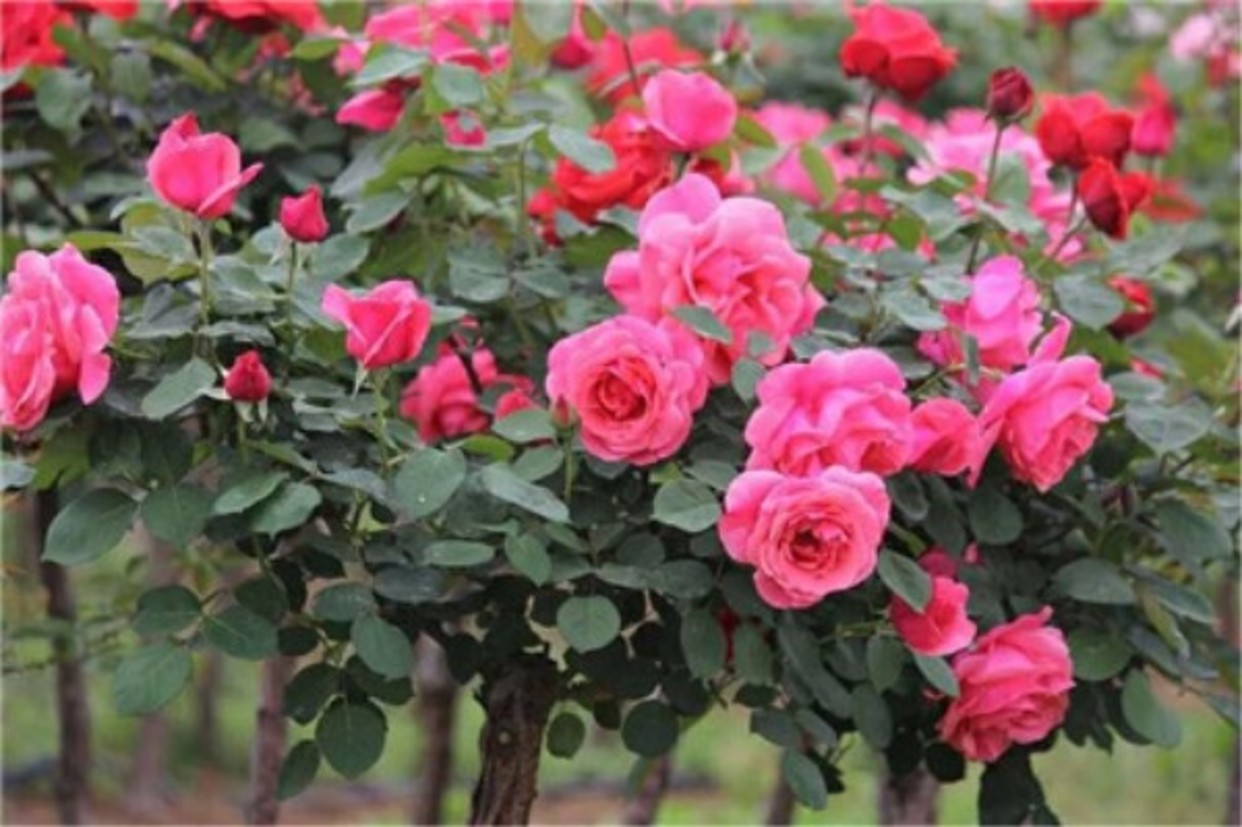
新叶发黄
有些花友新买的月季没几天,月季就开始从“头”发黄了,主要是新叶,老叶也没啥事

原因:1、浇水过多;2、缺铁元素
花友们根据排除法,看看自家的月季到底是哪种诱因,一般连土一起买回家的不会立即缺铁,搞不好就是水浇多啦
对策:
1、减少浇水,盆土干了再浇
2、浇硫酸亚铁溶液,或者淘米水发酵1-2周,兑70%的清水,浇在盆土里,不要浇到月季上
老叶黄掉
一看到叶子都这么黄了,花友就急的不行,这可咋办?哈哈,这下真是瞎着急了,你的月季什么病都没有
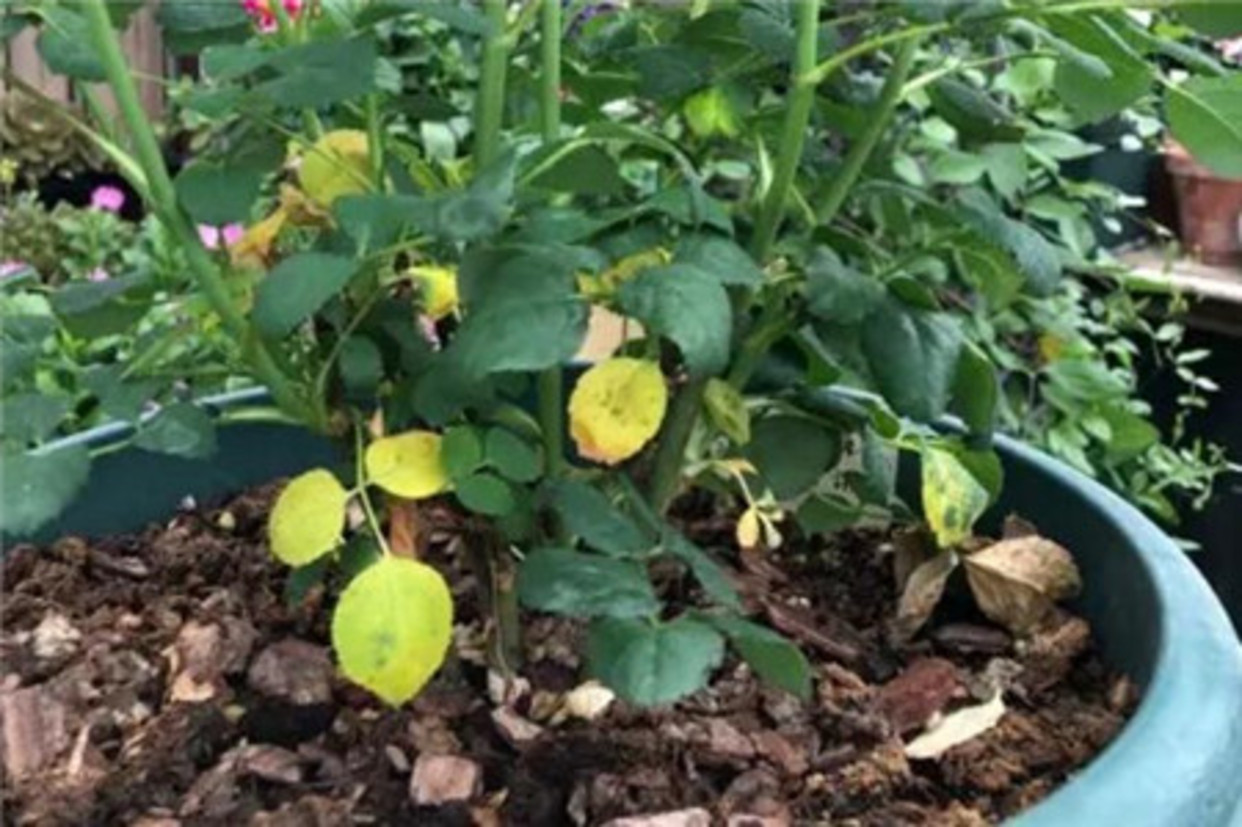
原因:正常新陈代谢,自然新老更替
月季长势快,新叶子不断冒出来,底部的老叶子当然自然“退休”了
对策:
直接摘掉老叶,不要留在盆里,避免腐烂滋生细菌,引发其他病变
老叶尖发黄、干枯
如果月季的老叶没有全黄,而是从叶尖开始发黄,干枯,这不是自然老化,而是缺营养!
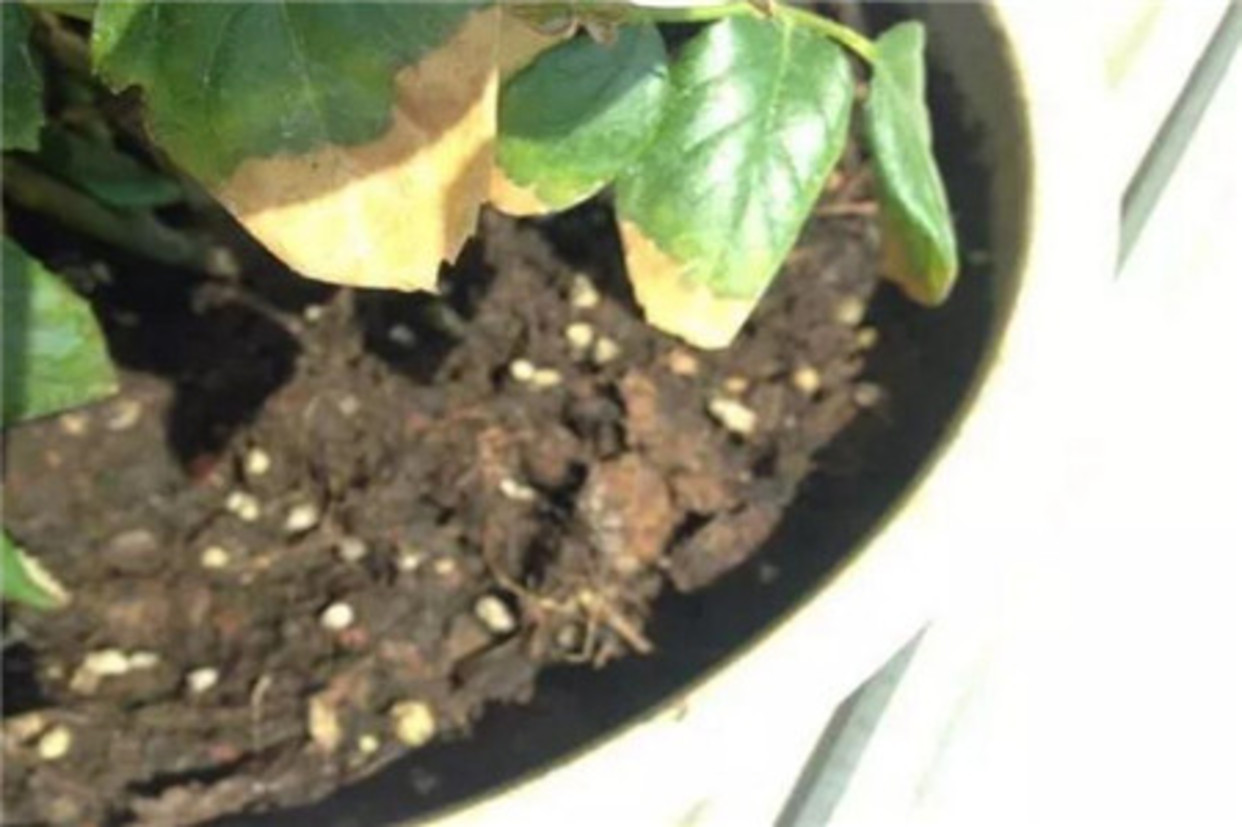
原因:缺钾
缺钾的月季不但叶子不正常,整棵长势也不明显,比较瘦弱,一般盆土里泥炭土、沙土居多的话,容易缺钾
对策:
1、添加一些腐叶土,增加全面营养
2、每月浇1-2次的硫酸钾溶液
3、摘掉老叶,不要放在盆里,避免腐烂滋生细菌
叶子发黄,凹凸不平
如果叶子发黄、泛橙色、叶脉颜色深,叶面有些凹凸起伏,也是缺了某种营养
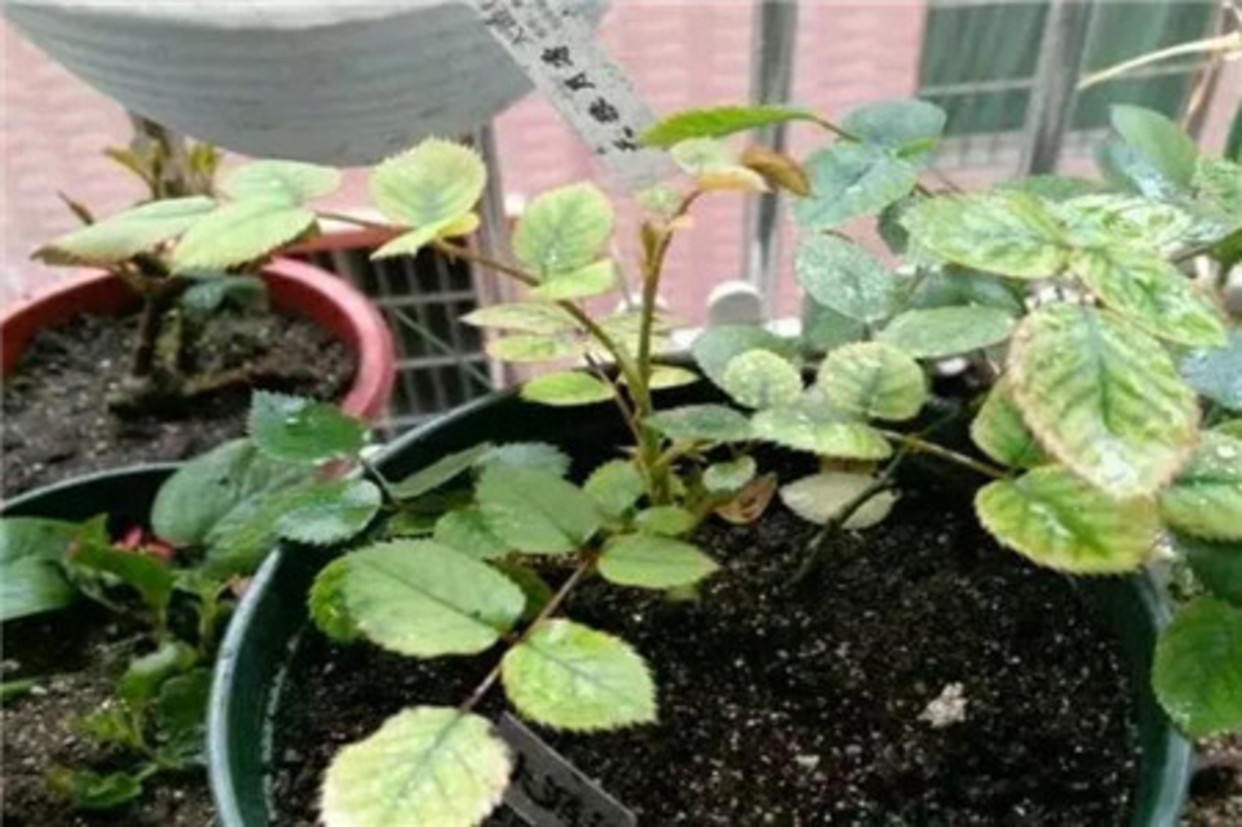
原因:缺镁、缺钙
一般缺镁和缺钙同时出现,月季开始生长不良,或停止生长,然后黄叶掉叶,这时候想开花都难
对策:
1、浇硫酸镁溶液(加水溶度为0.1%)
2、每月往盆土里掺2-5克骨粉;掺碎鸡蛋壳
3、大豆泡水,发酵1-2周后,兑水浇盆土里(浓度为0.2%)
叶子全黄
正长的壮的叶子完全没了绿色,连叶脉也变黄了,黄掉的叶子还带一点橙色、红色
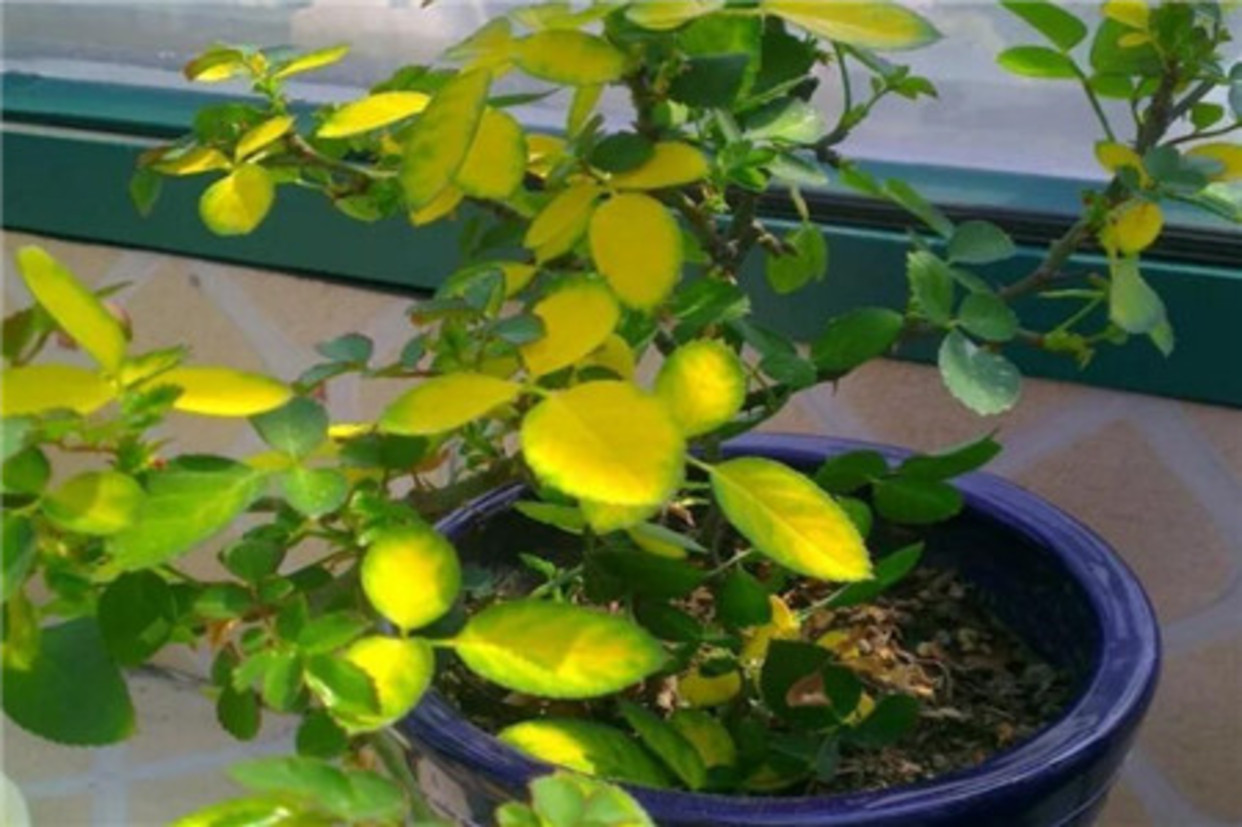
原因:缺硫、缺氮
缺硫一般是上面的叶子先黄,缺氮则是下面的叶子先黄,花友们可以根据黄叶的位置来判断
对策:
1、看盆土是否疏松,适当松土
2、摘除黄叶、修剪弱枝
3、追加氮肥、尿素,薄肥多施
4、添加粪肥、豆饼肥
叶子打卷、发黄
有些花友家的月季养的不错,养着养着叶子就卷了、黄了,有的甚至叶边焦黄,感觉好像被火烧过一样
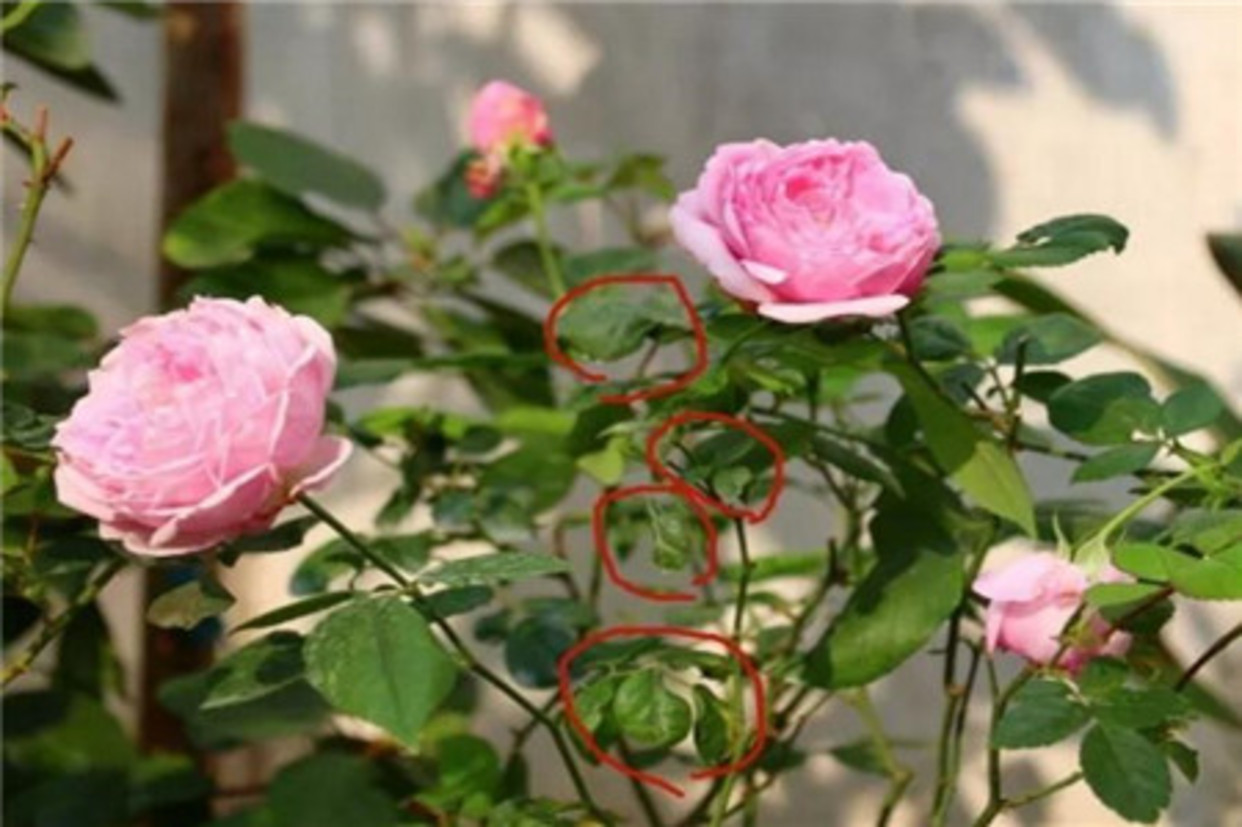
原因:1、肥大;2肥伤
叶子还是绿色有光泽,叶脉颜色深,排除虫害,应该是肥大或肥伤,这也不是好事,严重的话直接烧死月季
有些花友纳闷,我家都没施肥,怎么肥伤?有些地区下雨,导致土壤里的盐碱度增高,月季根系无法再吸收
对策:
1、停止加肥,如果只有几片叶子卷缩,就多浇几次水,冲淡肥力
2、堆肥的话,适当取出一点肥出来
3、比较严重的肥大现象,最好直接换土
4、肥伤,扒掉表层盆土,暂时控水,土干再浇,严重时直接换土
5
7
文章
Miss Chen
2018年06月18日

Description: This herbaceous perennial plant is 1-4' tall, branching occasionally. The stems are square or round, and usually pubescent where new growth occurs, becoming glabrous with age. The hairless leaves are opposite or alternate along the stems, sessile or with short petioles, and up to 4" long and ½" across. They are narrowly lanceolate in shape, and sometimes have purple veins or spots. There are 4-8 teeth per centimeter along the margin of each leaf.
From the upper axils of some of the upper leaves, there appears a single flower with a long calyx tube on a short stalk (peduncle). This calyx tube is pubescent and more or less erect, terminating in 4 lanceolate sepals that often tinted purple or pink. These sepals are a little shorter than the petals. The 4 notched petals are white or light pink, and span about 1/3" across. At the throat of the flower, there is a prominent pistil that is often knobby at the end, which is surrounded by several stamens. These flowers bloom for about a month during late summer or early fall. The calyx tube matures into an elongated seed capsule, which splits open to release a multitude of tiny seeds with small tufts of reddish brown hair. These seeds are distributed by the wind. The root system is fibrous and produces rhizomes, which enables this plant to spread vegetatively.
Cultivation: The preference is full sun to light shade, and wet to moist conditions. The soil should contain lots of organic material to retain moisture. The foliage is rather fragile and can become damaged easily. This plant tolerates occasional flooding, and prefers rather cool conditions.
Range & Habitat: The native Cinnamon Willow-Herb occurs occasionally in northern and central Illinois, but it is uncommon or absent in the southern section of the state. Its range extends further to the south than other Epilobium spp., which are usually restricted to northern Illinois. Habitats include poorly drained areas of black soil prairies, moist woodlands, woodland borders, and various kinds of wetlands, including marshes, bogs, fens, seeps, and edges of ponds, rivers, or drainage ditches. The Willow Herbs are pioneer species that thrive on some kind of disturbance, such as fire.
Faunal Associations: The flowers probably attract bees and flower flies, which seek nectar and pollen. The caterpillars of various moths eat the foliage of Willow-Herbs, including Hyles lineata (White-Lined Sphinx), Eudryas unio (Pearly Wood Nymph), Anticlea multiferata (Many-Lined Carpet), and Scythris magnabella (Scythridid Moth sp.). The seeds are too small to be of much interest to birds. The foliage is non-toxic and occasionally eaten by mammalian herbivores, but it has low food value.
Photographic Location: A poorly drained area of prairie in Meadowbrook Park, Urbana, Illinois.
Comments: The flowers are rather small-sized, but they are often produced in abundance on large plants. The most distinctive characteristic of Cinnamon Willow-Herb is the reddish brown coloration of the tufts of hair on the seeds, which is responsible for the common name of this plant. Other Epilobium spp. have tufts of hair that are white or faded brown or grey. Cinnamon Willow-Herb also has serrated leaves with 4-8 teeth per centimeter, while other Willow-Herbs have leaves with either smooth edges or fewer teeth per centimeter. An unusual characteristic of the Willow-Herbs is the long calyx-tube of the flowers, which occurs behind the petals, and eventually becomes an elongated seed capsule. It looks like a flowering stalk (peduncle), but it is actually part of the flower where the ovaries are contained. In some members of the Mustard family and miscellaneous other plants, an elongated seed capsule develops in front of the petals. This is one way to determine whether the plant in front of you is a Willow-Herb, or a quite different species of plant.
From the upper axils of some of the upper leaves, there appears a single flower with a long calyx tube on a short stalk (peduncle). This calyx tube is pubescent and more or less erect, terminating in 4 lanceolate sepals that often tinted purple or pink. These sepals are a little shorter than the petals. The 4 notched petals are white or light pink, and span about 1/3" across. At the throat of the flower, there is a prominent pistil that is often knobby at the end, which is surrounded by several stamens. These flowers bloom for about a month during late summer or early fall. The calyx tube matures into an elongated seed capsule, which splits open to release a multitude of tiny seeds with small tufts of reddish brown hair. These seeds are distributed by the wind. The root system is fibrous and produces rhizomes, which enables this plant to spread vegetatively.
Cultivation: The preference is full sun to light shade, and wet to moist conditions. The soil should contain lots of organic material to retain moisture. The foliage is rather fragile and can become damaged easily. This plant tolerates occasional flooding, and prefers rather cool conditions.
Range & Habitat: The native Cinnamon Willow-Herb occurs occasionally in northern and central Illinois, but it is uncommon or absent in the southern section of the state. Its range extends further to the south than other Epilobium spp., which are usually restricted to northern Illinois. Habitats include poorly drained areas of black soil prairies, moist woodlands, woodland borders, and various kinds of wetlands, including marshes, bogs, fens, seeps, and edges of ponds, rivers, or drainage ditches. The Willow Herbs are pioneer species that thrive on some kind of disturbance, such as fire.
Faunal Associations: The flowers probably attract bees and flower flies, which seek nectar and pollen. The caterpillars of various moths eat the foliage of Willow-Herbs, including Hyles lineata (White-Lined Sphinx), Eudryas unio (Pearly Wood Nymph), Anticlea multiferata (Many-Lined Carpet), and Scythris magnabella (Scythridid Moth sp.). The seeds are too small to be of much interest to birds. The foliage is non-toxic and occasionally eaten by mammalian herbivores, but it has low food value.
Photographic Location: A poorly drained area of prairie in Meadowbrook Park, Urbana, Illinois.
Comments: The flowers are rather small-sized, but they are often produced in abundance on large plants. The most distinctive characteristic of Cinnamon Willow-Herb is the reddish brown coloration of the tufts of hair on the seeds, which is responsible for the common name of this plant. Other Epilobium spp. have tufts of hair that are white or faded brown or grey. Cinnamon Willow-Herb also has serrated leaves with 4-8 teeth per centimeter, while other Willow-Herbs have leaves with either smooth edges or fewer teeth per centimeter. An unusual characteristic of the Willow-Herbs is the long calyx-tube of the flowers, which occurs behind the petals, and eventually becomes an elongated seed capsule. It looks like a flowering stalk (peduncle), but it is actually part of the flower where the ovaries are contained. In some members of the Mustard family and miscellaneous other plants, an elongated seed capsule develops in front of the petals. This is one way to determine whether the plant in front of you is a Willow-Herb, or a quite different species of plant.
0
0
文章
Miss Chen
2018年06月17日

Description: This plant is a small much-branched shrub about 1½–3' tall. The bark of the woody branches is reddish brown to grayish brown, becoming shredded and ragged-looking with age. The alternate leaves are about ½–1" long and across; they are divided into 3-7 narrow pinnate lobes and their margins are smooth and revolute (folded downward). The lobes often appear to be palmate because they are crowded together; they are linear-oblong in shape. The upper surface of each leaf is medium to dark green and sparsely covered with fine silky hairs; the lower surface is pale green and more densely covered with fine hairs. The leaves have short petioles.
The upper branches produce either individual or small clusters of yellow flowers. Each flower spans about ¾–1½" across; it has 5 yellow petals that are well-rounded, 5 yellowish green sepals, 15-20 stamens with flat golden anthers, and multiple carpels (female reproductive organs) that are crowded together in the center. The sepals are ovate in shape and sparsely covered with fine silky hairs. On a particular shrub, many flowers may bloom at once, or only a few flowers at a time. The blooming period occurs during the summer and early fall; a small colony of shrubs may remain in bloom for 2-3 months. Each flower is replaced by a capsule that contains several hairy seeds. Mature capsules become dark brown and persist into the winter. The root system consists of a woody taproot.
Cultivation: Shrubby Cinquefoil prefers full sun, moist conditions, and a sandy or rocky soil containing calcium. The pH of the soil should be slightly acid to alkaline. Shrubby Cinquefoil can be cultivated in a garden soil containing loam or clay-loam, and it will adapt to drier situations.

Range & Habitat: Shrubby Cinquefoil is a rare plant in Illinois; it is found primarily in a few counties in the NE section of the state (see Distribution Map), where it is native. Habitats include fens, calcareous seeps, the upper portion of beaches and low sandy areas along Lake Michigan, sandy banks of interdunal ponds, moist dolomite prairies, and hill prairies. The last habitat is highly atypical. Shrubby Cinquefoil is typically found in calcareous wetlands near Lake Michigan and other Great Lakes; it rarely naturalizes in disturbed areas. Because of its attractive flowers and easy culture, Shrubby Cinquefoil is often cultivated as an ornamental plant in gardens and lawns. This circumboreal shrub is also native to Eurasia.
Faunal Associations: According to observations of Müller (1873/1883) in Germany, the nectar and pollen of the flowers attract honeybees, Halictid bees, Sphecid wasps, and various flies. Observed fly visitors include: Soldier flies, Syrphid flies, Thick-headed flies, Flesh flies (Sarcophaga spp.), Blow flies (Lucilia spp.), Dung flies (Scatophaga spp., Sepsis spp.), and Anthomyiid flies. The caterpillars of the butterfly Lycaena dorcas (Dorcas Copper) feed on the foliage of Shrubby Cinquefoil, while the caterpillars of the moth Scopula limboundata (Large Lace Border) eat the flowers. Another insect that feeds on Shrubby Cinquefoil is the flea beetle Macrohaltica caurina. With the exception of goats, hoofed mammalian herbivores don't browse on this shrub to any significant extent.

Photographic Location: A roadside garden in Champaign, Illinois.
Comments: Other scientific names for this species includes Potentilla fruticosa and Pentaphylloides floribunda. While the floral structure of Shrubby Cinquefoil (Dasiphora fruticosa) resembles that of the various cinquefoil species (Potentilla spp.), the latter are non-woody plants with smaller flowers (¼–¾" across). Another species, Three-toothed Cinquefoil (Sibbaldiopsis tridentata), is a low woody plant with small white flowers; it more closely resembles a wild strawberry (Fragaria sp.) than Shrubby Cinquefoil.
The upper branches produce either individual or small clusters of yellow flowers. Each flower spans about ¾–1½" across; it has 5 yellow petals that are well-rounded, 5 yellowish green sepals, 15-20 stamens with flat golden anthers, and multiple carpels (female reproductive organs) that are crowded together in the center. The sepals are ovate in shape and sparsely covered with fine silky hairs. On a particular shrub, many flowers may bloom at once, or only a few flowers at a time. The blooming period occurs during the summer and early fall; a small colony of shrubs may remain in bloom for 2-3 months. Each flower is replaced by a capsule that contains several hairy seeds. Mature capsules become dark brown and persist into the winter. The root system consists of a woody taproot.
Cultivation: Shrubby Cinquefoil prefers full sun, moist conditions, and a sandy or rocky soil containing calcium. The pH of the soil should be slightly acid to alkaline. Shrubby Cinquefoil can be cultivated in a garden soil containing loam or clay-loam, and it will adapt to drier situations.

Range & Habitat: Shrubby Cinquefoil is a rare plant in Illinois; it is found primarily in a few counties in the NE section of the state (see Distribution Map), where it is native. Habitats include fens, calcareous seeps, the upper portion of beaches and low sandy areas along Lake Michigan, sandy banks of interdunal ponds, moist dolomite prairies, and hill prairies. The last habitat is highly atypical. Shrubby Cinquefoil is typically found in calcareous wetlands near Lake Michigan and other Great Lakes; it rarely naturalizes in disturbed areas. Because of its attractive flowers and easy culture, Shrubby Cinquefoil is often cultivated as an ornamental plant in gardens and lawns. This circumboreal shrub is also native to Eurasia.
Faunal Associations: According to observations of Müller (1873/1883) in Germany, the nectar and pollen of the flowers attract honeybees, Halictid bees, Sphecid wasps, and various flies. Observed fly visitors include: Soldier flies, Syrphid flies, Thick-headed flies, Flesh flies (Sarcophaga spp.), Blow flies (Lucilia spp.), Dung flies (Scatophaga spp., Sepsis spp.), and Anthomyiid flies. The caterpillars of the butterfly Lycaena dorcas (Dorcas Copper) feed on the foliage of Shrubby Cinquefoil, while the caterpillars of the moth Scopula limboundata (Large Lace Border) eat the flowers. Another insect that feeds on Shrubby Cinquefoil is the flea beetle Macrohaltica caurina. With the exception of goats, hoofed mammalian herbivores don't browse on this shrub to any significant extent.

Photographic Location: A roadside garden in Champaign, Illinois.
Comments: Other scientific names for this species includes Potentilla fruticosa and Pentaphylloides floribunda. While the floral structure of Shrubby Cinquefoil (Dasiphora fruticosa) resembles that of the various cinquefoil species (Potentilla spp.), the latter are non-woody plants with smaller flowers (¼–¾" across). Another species, Three-toothed Cinquefoil (Sibbaldiopsis tridentata), is a low woody plant with small white flowers; it more closely resembles a wild strawberry (Fragaria sp.) than Shrubby Cinquefoil.
0
0





